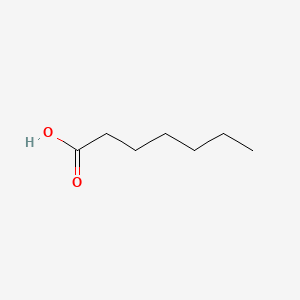| MeSH term | MeSH ID | Detail |
|---|---|---|
| Olfaction Disorders | D000857 | 17 associated lipids |
| Byssinosis | D002095 | 11 associated lipids |
| Mitochondrial Diseases | D028361 | 25 associated lipids |
HEPTANOIC ACID
HEPTANOIC ACID is a lipid of Fatty Acyls (FA) class. Heptanoic acid is associated with abnormalities such as Dehydration. The involved functions are known as Process, Anabolism, inhibitors, Oxidation and fatty acid oxidation. The related lipids are Heptanoates and undecanoic acid.
Cross Reference
Introduction
To understand associated biological information of HEPTANOIC ACID, we collected biological information of abnormalities, associated pathways, cellular/molecular locations, biological functions, related genes/proteins, lipids and common seen animal/experimental models with organized paragraphs from literatures.
What diseases are associated with HEPTANOIC ACID?
HEPTANOIC ACID is suspected in Dehydration and other diseases in descending order of the highest number of associated sentences.
Related references are mostly published in these journals:
| Disease | Cross reference | Weighted score | Related literature |
|---|
Possible diseases from mapped MeSH terms on references
We collected disease MeSH terms mapped to the references associated with HEPTANOIC ACID
PubChem Associated disorders and diseases
What pathways are associated with HEPTANOIC ACID
There are no associated biomedical information in the current reference collection.
PubChem Biomolecular Interactions and Pathways
Link to PubChem Biomolecular Interactions and PathwaysWhat cellular locations are associated with HEPTANOIC ACID?
There are no associated biomedical information in the current reference collection.
What functions are associated with HEPTANOIC ACID?
Related references are published most in these journals:
| Function | Cross reference | Weighted score | Related literatures |
|---|
What lipids are associated with HEPTANOIC ACID?
Related references are published most in these journals:
| Lipid concept | Cross reference | Weighted score | Related literatures |
|---|
What genes are associated with HEPTANOIC ACID?
There are no associated biomedical information in the current reference collection.
What common seen animal models are associated with HEPTANOIC ACID?
There are no associated biomedical information in the current reference collection.
NCBI Entrez Crosslinks
All references with HEPTANOIC ACID
Download all related citations| Authors | Title | Published | Journal | PubMed Link |
|---|---|---|---|---|
| Sinha-Hikim I et al. | Testosterone-induced muscle hypertrophy is associated with an increase in satellite cell number in healthy, young men. | 2003 | Am. J. Physiol. Endocrinol. Metab. | pmid:12670837 |
| Zitzmann M et al. | Prostate volume and growth in testosterone-substituted hypogonadal men are dependent on the CAG repeat polymorphism of the androgen receptor gene: a longitudinal pharmacogenetic study. | 2003 | J. Clin. Endocrinol. Metab. | pmid:12727953 |
| Huber C et al. | Evaluation of long-term sedation in cheetah (Acinonyx jubatus) with perphenazine enanthate and zuclopenthixol acetate. | 2001 | J. Zoo Wildl. Med. | pmid:12785681 |
| Crescioli C et al. | Inhibition of spontaneous and androgen-induced prostate growth by a nonhypercalcemic calcitriol analog. | 2003 | Endocrinology | pmid:12810561 |
| Matsunami H and Amrein H | Taste and pheromone perception in mammals and flies. | 2003 | Genome Biol. | pmid:12844351 |
| Bondanelli M et al. | Activation of the somatotropic axis by testosterone in adult men: evidence for a role of hypothalamic growth hormone-releasing hormone. | 2003 | Neuroendocrinology | pmid:12845224 |
| Mauras N et al. | Synergistic effects of testosterone and growth hormone on protein metabolism and body composition in prepubertal boys. | 2003 | Metab. Clin. Exp. | pmid:12898459 |
| Chu KS et al. | The antinociceptive effect of nalbuphine and its long-acting esters in rats. | 2003 | Anesth. Analg. | pmid:12933406 |
| Weinbauer GF et al. | Pharmacokinetics and degree of aromatization rather than total dose of different preparations determine the effects of testosterone: a nonhuman primate study in Macaca fascicularis. | 2003 Sep-Oct | J. Androl. | pmid:12954670 |
| Becker R | [Fluorometric determination of glibornuride in plasma and serum using 7-chloro-4-nitrobenzo-2-oxa-1,3-diazole]. | 1977 | Arzneimittelforschung | pmid:139896 |
